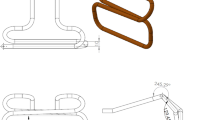Abstract
The application of vacuum venting for the removal of air from mould cavity has been introduced in injection moulding with the intent to enhance micro/nano features replication and definition. The technique is adopted to remove air pockets trapped in the micro-features, which are out of reach for conventional venting technologies and can create considerable resistance to the melt filling flow. Nonetheless, several studies have revealed a negative effect on replication that could possibly arise from the application of vacuum venting. Although the incomplete filling of micro-scale features has often been attributed to poor venting, the limited research examining the application of vacuum venting has produced mixed results. In this work, the effect of air evacuation was experimentally investigated, monitoring mould and polymer temperature evolution during the micro injection moulding process by means of a high-speed infrared camera and a sapphire window, which forms part of the mould wall. The results show that air evacuation removes a mould surface heating effect caused by rapid compression of the air ahead of the flow front and subsequent conduction of that heat into the mould surface. Hence, with the increase of the surface-to-volume ratio in micro-cavities, air evacuation has a detrimental effect on the cavity filling with polymers that are sensitive to changes of the mould temperature.
Similar content being viewed by others
References
Masato D, Sorgato M, Lucchetta G (2016) Analysis of the influence of part thickness on the replication of micro-structured surfaces by injection molding Materials & Design
Ong Nan Shing, Zhang Honglin, Woo Wai Hoong (2006) Plastic injection molding of high-aspect ratio micro-rods. Mater Manuf Process 21(8):824–831
Griffiths CA, Dimov SS, Scholz S, Tosello G (2011) Cavity air flow behavior during filling in microinjection molding. J Manuf Sci Eng 133(1):011006
Liou A-C, Chen R-H (2006) Injection molding of polymer micro-and sub-micron structures with high-aspect ratios. Int J Adv Manuf Technol 28(11–12):1097–1103
Lin H-Y, Young W-B (2009) Analysis of the filling capability to the microstructures in micro-injection molding. Appl Math Model 33(9):3746–3755
Qi C-Z, Wang Y-T, Zhuang J, Zhang Y-J (2012) The study of injection compression molding of thin-wall light-guide plates with hemispherical micro structures. Proceedings of the 1st International Conference on Mechanical Engineering and Material Sceince MEMS
Sorgato M, Lucchetta G, Savio E (2014) Evaluation of vacuum venting and variotherm process for improving the replication by injection moulding of high aspect ratio micro features for biomedical applications. 1, 89–92
Lucchetta G, Fiorotto M, Bariani PF (2012) Influence of rapid mold temperature variation on surface topography replication and appearance of injection-molded parts. CIRP Ann Manuf Technol 61(1):539–542
Chien R-D (2006) Micromolding of biochip devices designed with microchannels. Sens Actuators, A 128 (2):238–247
Yoon S-H, Padmanabha P, Cha N-G, Mead JL, Barry CMF (2011) Evaluation of vacuum venting for micro-injection molding. Int Polym Process 26(4):346–353
Piotter V, Hanemann T, Ruprecht R, Hauß elt J (1997) Injection molding and related techniques for fabrication of microstructures. Microsyst Technol 3(3):129–133
Georg PMM, Michaeli W (2001) Introduction to micro fabrication Hanser
Han X, Yokoi H (2006) Visualization analysis of the filling behavior of melt into microscale v-grooves during the filling stage of injection molding. Polym Eng Sci 46(11):1590– 1597
Lin Y-CS, Shah J, Liwei (2004) Implementation and analysis of polymeric microstructure replication by micro injection molding. J Micromech Microeng 14(3):415
Sha B, Dimov S, Griffiths C, Packianather MS (2007) Investigation of micro-injection moulding: factors affecting the replication quality. J Mater Process Technol 183(2):284–296
Lucchetta G, Sorgato M, Carmignato S, Savio E (2014) Investigating the technological limits of micro-injection molding in replicating high aspect ratio micro-structured surfaces. CIRP Ann Manuf Technol 63 (1):521–524
Yokoi H, Han X, Takahashi T, Kim WK (2006) Effects of molding conditions on transcription molding of microscale prism patterns using ultra-high-speed injection molding. Polym Eng Sci 46(9):1140–1146
Montgomery DC (2008) Design and analysis of experiments. John Wiley & Sons
Author information
Authors and Affiliations
Corresponding author
Rights and permissions
About this article
Cite this article
Sorgato, M., Babenko, M., Lucchetta, G. et al. Investigation of the influence of vacuum venting on mould surface temperature in micro injection moulding. Int J Adv Manuf Technol 88, 547–555 (2017). https://doi.org/10.1007/s00170-016-8789-8
Received:
Accepted:
Published:
Issue Date:
DOI: https://doi.org/10.1007/s00170-016-8789-8




